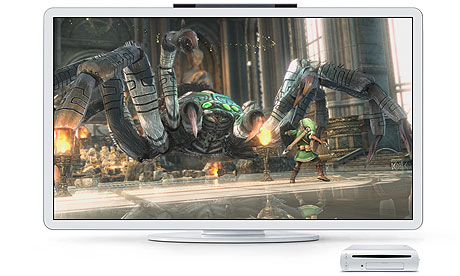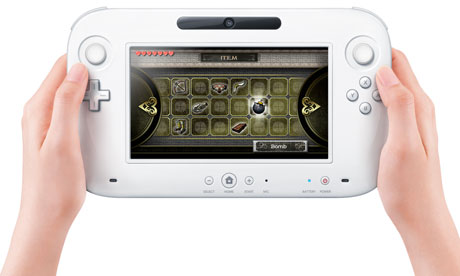http://www.guardian.co.uk/technology/2011/jun/07/wii-u-nintendo-games-console


With its tablet-like controller, the Wii U is a seriously weird piece of kit. But, yet again, once you get your hands on it, a multitude of new gaming experiences tumble out of it. And the machine will have more hardcore appeal, too.

When looking at the Nintendo Wii U, it's important to remember that when the Wii launched in 2006, some people laughed at the console's intention to "disrupt" gaming.It didn't look like a disruptive piece of kit – but it was. The proof lies in the fact that Microsoft and Sony subsequently felt obliged to create the Kinect and Move, not to mention the entire generation of people it introduced to video games. But surely it couldn't pull of the same trick again with Wii U?
Oh yes it can. Although there was trepidation mixed in with the excitement when we pitched up at Nintendo's still half-built booth at E3, on the day before the press conference at which it would launch Wii U, for an ultra-exclusive sneak preview of the new console.
Which was conducted in a gloriously cloak-and-dagger manner – a wristband had to be obtained, security insisted we hide our press badge, we were given a lengthy list of questions we couldn't ask, photography and audio-recording devices were strictly banned, and we had to wait outside a demo room sealed by a blast-door that would tax a professional safe cracker.
Upon entering the inner sanctum, Wii U itself, although apparently hooked up to a big screen, initially remained concealed – indeed, the console remained a shadowy presence throughout, partly hidden in a cupboard. What we could see of it resembled a slightly more rounded Wii, but in truth, it looked like a prototype not yet given the benefit of an industrial designer.
We were told that none of the games we would be playing were actual games, but rather tech-demos. And our first glimpse of anything running on the console was emphatically that: a lengthy fly-through in an immaculately constructed virtual Japanese garden, from the viewpoint of various birds, designed to show off Wii U's graphics-processing power.
Which was impressive if not jaw-dropping – on a par with the PlayStation 3 and Xbox 360, running in full HD, with depth of focus and convincingly modelled water and weather effects. We had established that Wii U will be able to run the sort of third-party titles that currently only make it onto the PlayStation 3 and Xbox 360, but before long, we began to yearn for some signs of Nintendo's fabled disruptive gameplay.
What the hell is that?
They weren't long in coming. With a theatrical flourish, the new controller was produced. On clapping eyes on it, our initial reaction ran thus. What? The hell? Is that?
Oh yes it can. Although there was trepidation mixed in with the excitement when we pitched up at Nintendo's still half-built booth at E3, on the day before the press conference at which it would launch Wii U, for an ultra-exclusive sneak preview of the new console.
Which was conducted in a gloriously cloak-and-dagger manner – a wristband had to be obtained, security insisted we hide our press badge, we were given a lengthy list of questions we couldn't ask, photography and audio-recording devices were strictly banned, and we had to wait outside a demo room sealed by a blast-door that would tax a professional safe cracker.
Upon entering the inner sanctum, Wii U itself, although apparently hooked up to a big screen, initially remained concealed – indeed, the console remained a shadowy presence throughout, partly hidden in a cupboard. What we could see of it resembled a slightly more rounded Wii, but in truth, it looked like a prototype not yet given the benefit of an industrial designer.
We were told that none of the games we would be playing were actual games, but rather tech-demos. And our first glimpse of anything running on the console was emphatically that: a lengthy fly-through in an immaculately constructed virtual Japanese garden, from the viewpoint of various birds, designed to show off Wii U's graphics-processing power.
Which was impressive if not jaw-dropping – on a par with the PlayStation 3 and Xbox 360, running in full HD, with depth of focus and convincingly modelled water and weather effects. We had established that Wii U will be able to run the sort of third-party titles that currently only make it onto the PlayStation 3 and Xbox 360, but before long, we began to yearn for some signs of Nintendo's fabled disruptive gameplay.
What the hell is that?
They weren't long in coming. With a theatrical flourish, the new controller was produced. On clapping eyes on it, our initial reaction ran thus. What? The hell? Is that?


